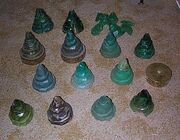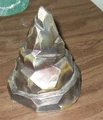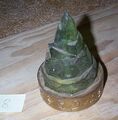Arguably the most powerful artifact in the Xenaverse, the Kronos Stone (also known as the "Quallus Crystal") is named for Kronos, the King of the Titans and father of Zeus.
History[]
Zeus reveals to Hercules that it is the Kronos Stone which gave him the power to overthrow and imprison the Titans. Hera steals it from Zeus and briefly frees three of the Titans in an attempted coup of Olympus (Hercules and Xena - The Animated Movie: The Battle for Mount Olympus).
At some point, the Stone is broken into pieces. As a measure to prevent them from being abused, the Stone(s) can only be wielded by a god once it/they have been granted to them by a mortal (this was not the case of demi-gods). Ares tells Strife and Discord that it took him 800 years to obtain two of the pieces. A third was donated by someone as a prize in a mortal talent competition to take place at Kora's Inn. Ares entered the competition to try to win the Stone but tied with Hercules and Iolaus. After a brief fight, Hercules through the Stone into the ocean. When Hercules briefly has possession of the Stone he is able to throw lightning bolts to attack ares, but the power is irregular and difficult to control ("The Prize").
Years later, Autolycus steals the Kronos Stone from King Quallus he and Hercules discover that it can manipulate time. Hercules is able to use it to save Serena's life before he destroys it to prevent any further changes to the timeline (HTLJ "The End of the Beginning)."
When Ares sends Iolaus back in time to stop Callisto from killing Alcmene he finds that Empress Xena has the Kronos Stone on her sceptre. He manages to steal it and travel further back in time to save Alcmene and the unborn Hercules. When Iolaus travels back into the present, Callisto destroys the Kronos Stone by melting it in front of the Halls of War (HTLJ "Armageddon Now Part 2").
The shards of the original Kronos Stone, broken by Hercules, were given to the Shimax Amazon tribe by Artemis for their protection. When Deimos discovered this he forced them to reveal the stone's location to him so that he could overthrow Zeus. Hercules was able to get the partially-reformed stone away from Deimos before he became too powerful. The hero sent the stone flying into the atmosphere (HTLJ "Love, Amazon Style").
Gallery[]
Background[]
- There is some historical/mythological precedence for a Kronos Stone. For fear that his children would usurp his rule, after each one was born, Kronos would devour them. When Zeus was born, Rhea hid the child and presented Kronos with a stone, which he swallowed. Later, when Zeus and Metis made tricked Kronos into vomiting up his other children. the stone was taken by two eagles to the "centre of the world." Due to the fact that the Greeks couldn't agree to where that was, There were several of these stones, also called Omphalos stones, Omphalos meaning "navel". The most famous was at the Oracle of Delphi; another was said to be kept in the temple of Aphrodite on Cyprus.
- The stone also suffers from a common mythological confusion: Cronus (Κρονος) was the leader of the titans, but Chronos (Χρονος) was the god of time. In the original Greek, the spellings were similar but the pronunciations were very different; Latin and later English wound up with even more similar spellings and lost the differing pronunciation. This could explain the stone's original association with time travel (Chronos), and its later enhanced powers (Cronus). It's notable that the Xenaverse was one of the first modern retellings of Greek mythology to use the spelling "Kronos", which is closer to the original Greek spelling and helps distinguish the two.
Props[]
As with many props, a number of different versions of the Kronos Stone were made by the propmakers. A lot in the closing-down auction in Auckland included 13 Stones (one or more 'star' stones may have been auctioned in California).

Thirteen Kronos Stones
Starting from lower left in the photo the stones are as follows:
1. Translucent, yellow-green plastic, hollow, smooth & shiny
2. Solid, heavy plastic, brassy appearance (brass plated?)
3. Translucent, rubbery, hollow, green-tinted, tip 'broken' off
4. Translucent, green plastic, hollow, smooth & shiny
5. Heavy, dull grey-green solid plastic, satin finish; this may have been the master that the others were cast from
6. Whitish, translucent, hollow, glittery plastic, thin metallic green paint on tip
7. Clear plastic, hollow, green paint on lower 2/3ds, hole drilled through side of tip (for 'sparks' ?)
. Spare base
8. Translucent, hollow, yellowish-green plastic, mounted on 'brass'-coloured plastic base
9. Dull plastic, metallic green spray paint, mounted on 'brass'-coloured plastic base
10. Similar to 6
11. Translucent, green plastic, hollow, smooth & shiny. The best-looking one.
12. 'Broken' in two halves, soft foam rubber, metallic green paint sloughing off in places.
13. 'Broken' (sawn) in two halves, clear plastic filling, similar to (11)
. Broken fragments of stone


















